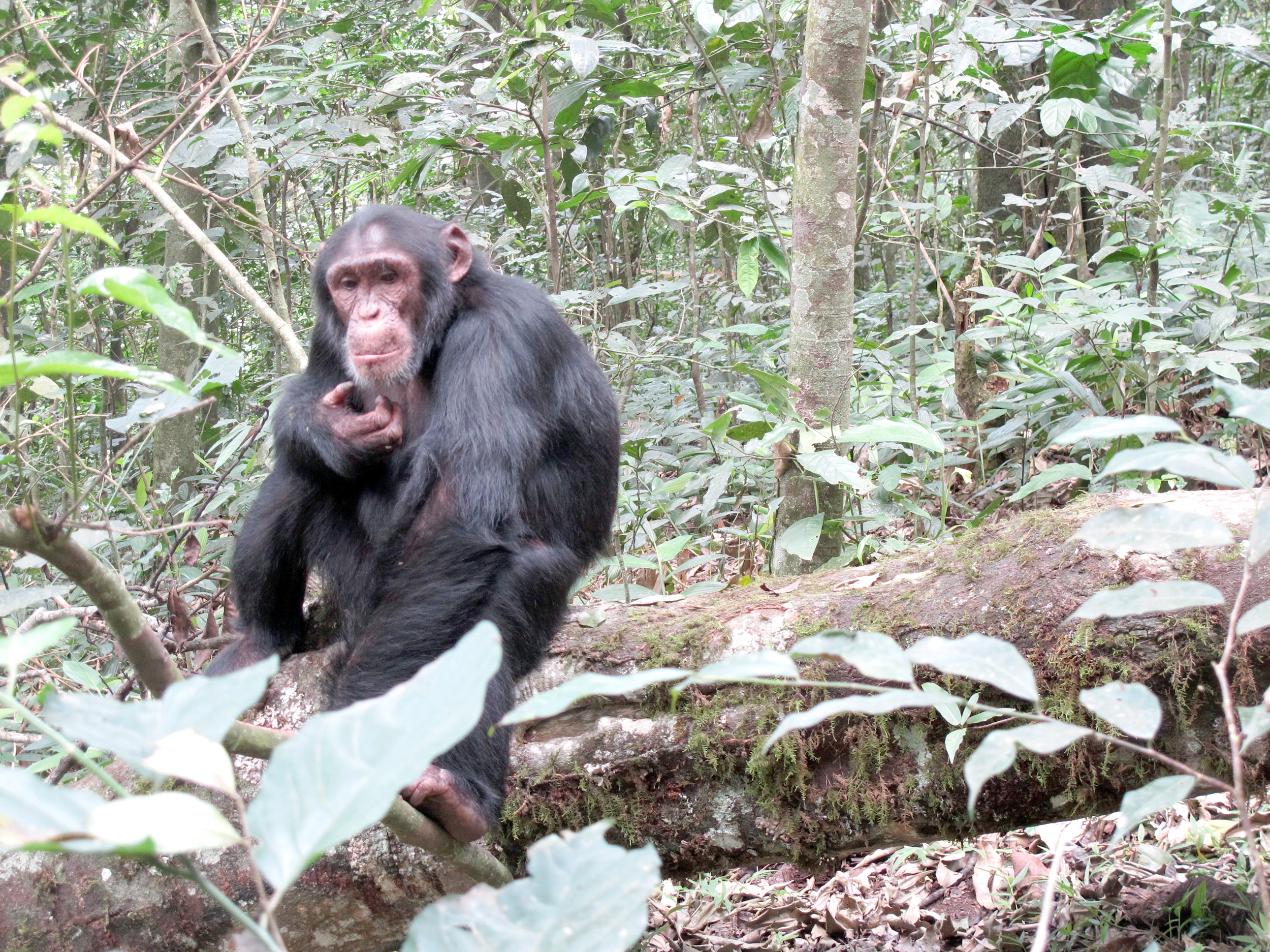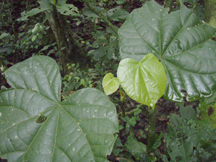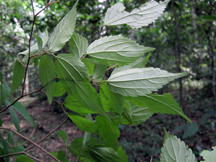Study: Chimpanzees eat smart when it comes to mealtime
March 20, 2013
 |
|
Pictured here is a chimpanzee from Ngogo in Uganda's Kibale National Park. Bryce
Carlson, a Purdue assistant professor of anthropology who studies primate
ecology and nutrition in human evolution, found that chimpanzees watch what
they eat and when, which may show that these primates are giving some thought
to the quality of their food. Data regarding the chimpanzees and two species of
saplings were collected from Ngogo. Carlson's
findings are published in the American
Journal of Primatology. (Photo provided by Bryce Carlson)
|
WEST LAFAYETTE, Ind. - Chimpanzees watch what they eat and when, which may show that these primates are giving some thought to the quality of their food, according to Purdue University research.
 |
|
Bryce
Carlson
|
"There is an association between the time of day primates eat certain resources and the nutritional quality of those resources, suggesting consumption may track nutrient content," said Bryce Carlson, an assistant professor of anthropology who studies primate ecology and nutrition in human evolution. "We can't say for sure if chimpanzees are consciously selecting the leaves when nutritional content is greatest, but this correlation presents an intriguing hypothesis to explain feeding behavior in this primate species and mechanisms for ingestive behavior in general."
The study's results are published in the April American Journal of Primatology, and this work was funded by the National Science Foundation and L.S.B. Leakey Foundation. Carlson, who is a member of Purdue's Ingestive Behavior Research Center, is studying the dietary habits of wild chimpanzees as part of his research on the history of diet in human evolution. These primates, which live in forest areas of Africa, are part of the hominidae family that also includes humans, gorillas and orangutans. It is estimated there are 300,000 chimpanzees in the wild.
Chimpanzees, whose diet is composed of fruit, leaves, plant stalks, roots, insects and other vertebrate animals, frequently consume various leaves at the end of the day. Other researchers have proposed the animals prefer eating leaves at that time to feel full and facilitate greater nutrient absorption overnight, or that this daily eating pattern results from social dynamics, where chimpanzees typically spend late afternoons in smaller foraging groups on the ground where these leaves are found.
 |
|
The
Pterygota mildbraedii is a large tree
common throughout the Ngogo chimpanzee habitat, and it is among the primate's key food sources. (Photo provided by Bryce Carlson)
|
"But we know there is a correlation between nutritional quality and daily feeding patterns for other animals, such as domesticated sheep," Carlson said. "So we wanted to take a closer look at chimpanzees by comparing the primates' feeding habits to the nutritional composition of these leaves throughout the day."
Data regarding the chimpanzees and two species of saplings, Pterygota mildbraedii and Celtis africana, were collected from Ngogo in Uganda's Kibale National Park. The Ngogo chimpanzee community is the largest observed in the world - more than 180 animals - and has been actively studied since 1995.
Daily feeding observations from 2002-2011, made primarily during the dry season months of June through August, of 41 adult male chimpanzees were analyzed for eating patterns. These were compared to nutrition samples from Pterygota mildbraedii and Celtis africana. Leaf samples were taken from different saplings and at various feeding times during the day.
Pterygota mildbraedii is a very large tree, common throughout the Ngogo chimpanzee habitat. The chimpanzees, however, eat young leaves of the saplings found near the forest floor. This study found that the leaves' hemicellulose - a more digestible fiber - and nonstructural carbohydrates - simple sugars and starch - increased 15 percent to 100 percent, respectively, from morning to evening. Cellulose and lignin, which make the leaves more difficult to digest, also decreased by day's end. Celtis africana is a smaller tree than Pterygota, the saplings of which contain many thin branches and small leaves. The sugars in this plant's leaves were found to double from morning to late afternoon.
 |
|
The
Celtis africana is a smaller tree
common throughout the Ngogo chimpanzee habitat, and it is among the primate's key food
sources. (Photo provided by Bryce Carlson)
|
"If these sugars or total non-structural carbohydrates are increasing, then the leaves are returning more calories late in the day," Carlson said. "At this time, they may taste sweeter, and the chimpanzees may then learn and adjust their feeding behavior accordingly. We know they use vision, texture, taste and smell to gauge when to eat fruit, so it's understandable to think they may do the same with leaves."
Carlson's research will continue to focus on diet for wild chimpanzees and human ancestors.
"Questions about what humans are eating today and why are important as our growing world population increasingly struggles with malnutrition tightly linked with quality of life, morbidity and mortality," Carlson said. "Evolution for any species is related to, and even driven by, food availability and quality, so the more we learn about our long history with food, the better able we are to make individual and population level recommendations for consumer behavior today and years to come."
Other partners that supported this study include Purdue's Department of Anthropology, Emory University, Hunter College of The City University of New York and the University of Michigan. Carlson also collaborated with the Ugandan Wildlife Authority and the Ugandan National Council for Sciences and Technology. The study co-authors are Jessica M. Rothman, an assistant professor of primate ecology at Hunter College of The City University of New York, and John C. Mitani, the James N. Spuhler Collegiate Professor at the University of Michigan.
Writer: Amy Patterson Neubert, 765-494-9723, apatterson@purdue.edu
Source: Bryce Carlson, bryce@purdue.edu
Note to Journalists: Journalists interested in a copy of the American Journal of Primatology article can contact Amy Patterson Neubert, Purdue News Service, at 765-494-9723, apatterson@purdue.edu
ABSTRACT
Diurnal Variation in Nutrients and Chimpanzee Foraging Behavior
Primate feeding behavior varies over long (e.g. weekly, seasonally, yearly) and short (e.g. hourly) scales of times due to changes in resources availability and the nutritional composition of foods. While the factors that affect long-term changes in feeding behavior have received considerable attention, few data exist regarding what drives variability in feeding behavior over the course of a single day. To address this problem, we investigated diurnal variation in chimpanzee feeding on the leaves of two species of saplings, Pterygota mildbraedii, and Celtis africana, at Ngogo, Kibale National Park, Uganda. Specifically, we related short-term changes in chimpanzee feeding behavior on these leaves to diurnal variation in their nutrition composition. Results showed that chimpanzees fed on the leaves of both saplings more in the evening than they did in the morning. The nutritional quality of leaves also improved over the course of the day. Concentration of cellulose and lignin were lower and total non-structural carbohydrates (including sugars and starch) were higher in the evening for P. mildbraedii, and sugars were higher in the evening for C. africana. These data suggest that chimpanzees consume these resources when their quality is highest, and consequently, may track the nutrient composition of their foods over very short periods that span only a few hours. In the future, foods collected for analyses must control for time of sampling to ensure biologically meaningful assays of nutrient composition.

